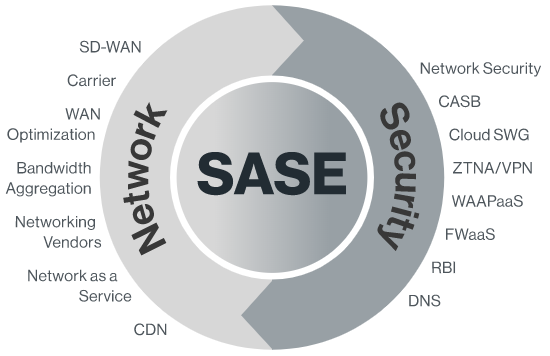
Secure Access Service Edge (SASE)
Solving emerging business challenges with point solutions

What is SASE?
Secure Access Service Edge (SASE) is a new enterprise networking category introduced by Gartner. SASE converges SD-WAN and network security point solutions (FWaaS, CASB, SWG, and ZTNA) into a unified, cloud-native service.
In the past, network access was implemented with point solutions, managed as silos that were complex and costly. This hurt IT agility.
With SASE, enterprises can reduce the time to develop new products, deliver them to the market, and respond to changes in business conditions or the competitive landscape.

What is Driving Adoption of SASE?

The transition to remote work and the emergence of a cloud-first culture are having a major impact on enterprise networks and information security. Networking patterns have changed, and organizations need to deploy new services and cater to new requirements faster than ever before.
A SASE architecture provides the agility and flexibility needed in this new environment. SASE makes it possible to deploy new branches remotely with low overhead. It also provides the security stack to ensure employees and contractors can access systems securely from anywhere.
As a result, Gartner predicts that 20% of organizations will soon use SWG, ZTNA, and FWaas from the same vendor (learn more about SASE components below). By 2024, at lease 40% of organizations will have an official SASE adoption strategy.
What are the Benefits of SASE?

Improving agility
With SASE, it is easy to deploy new resources. All you need is to deploy an edge client and connect it to the SASE platform. There is no need to maintain on-premise infrastructure.

Improving security via unified policies
SASE provides a full security stack, protecting all resources with a unified security policy. It provides full visibility into WAN and Internet traffic with no blind spots.

Simplifying the network stack
SASE provides a simpler network and security stack by consolidating multiple point solutions. It reduces upfront costs and eliminates the need for in-house management.
How Does SASE Work?
SASE provides a single cloud-based network that connects and secures any physical, cloud, or mobile enterprise resource, in any location. A SASE architecture has four main characteristics:

Identity-driven
User and resource identities determine the level of access, networking experience, and quality of service for every network connection, based on a unified organizational policy.

Cloud-native
SASE is elastic, self-healing, and self-maintaining. Its cloud native nature allows it to rapidly adapt to business needs and make network services available from any location.

Support for all edges
SASE can equally service any edge including on-premise data centers, branch offices, cloud resources, and mobile users on the go.

Globally distributed
SASE operates on a global scale to deliver all networking and security capabilities with high performance and low latency experience for all edges.
